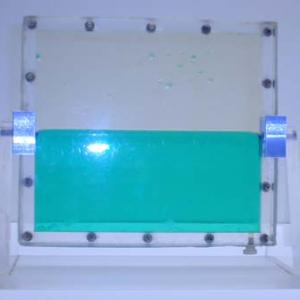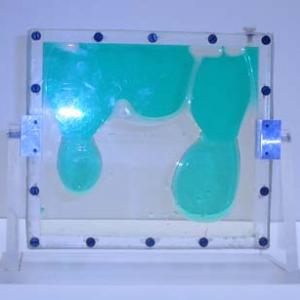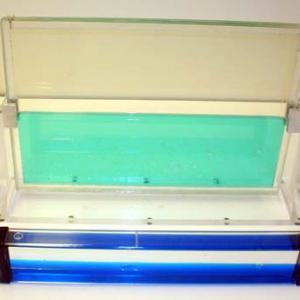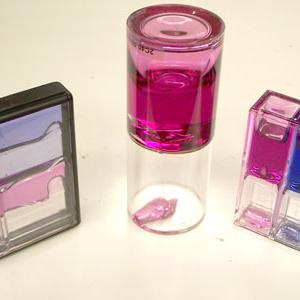College of Liberal Arts & Sciences
2C40.90 - Shock Wave Fronts: Rayleigh-Taylor Instability
See also 2C40.90 in Heat and Fluids.
This demo should need no preparation unless the liquids should need changing. To change the liquids it may be necessary to empty the unit with a syringe and long needle. Rinse several times with ethyl alcohol and dry with a small air hose. Use water and food coloring for the bottom layer and castor oil for the top layer. Make sure all air bubbles are removed. Place on a level surface. If the unit has not been used in a long time it may be a good idea to flip it over several times to rewet the inner walls with oil before demonstrating. As the Plexiglas allows water to pass over time, it will be necessary to take the air out and refill with a small amount of water about every year.
Tilt the wave vessels from side to side and observe the waves a curls produced by the shear force of the two fluids.
- Said Shakerin, "Coffee Painting", TPT, Vol. 62, #4, April 2024, p. 319.
- Hollis Williams, "Revisiting a Classic Magic Trick with Rayleigh-Taylor Instabilities", TPT, Vol. 61, #7, Oct. 2023, p. 621.
- Said Shakerin, "Fluids Demonstrations III: Viscous Flow in Modified Thin Enclosures, Centrifugal Effect, Vortical Flow, and Turbulence", TPT, Vol. 59, #7, Oct. 2021, p. 569.
- Said Shakerin, "Improved Demo of Granular Flow", TPT, Vol. 58, #3, Mar. 2020, p. 147.
- Said Shakerin, "Fluids Demonstrations II: Bubbles in Mondrian Painting, Eruption-Like Flow, Rotational Instability, and Wake Vortices", TPT, Vol. 57, #9, Dec. 2019, p. 600.
- Said Shakerin, "Fluids Demonstrations: Trailing Vortices, Plateau Border, Angle of Repose, and Flow Instability", TPT, Vol. 56, #4, Apr. 2018, p. 248.
- "Errata", TPT, Vol. 54, #2, Feb. 2016, p. 128.
- Asif Shakur, "Drops in 2D", TPT, Vol. 54, #1, Jan. 2016, p. 64.
- "Fluid Flow Disruption", TPT, Vo. 52, #8, Nov. 2014, p. 454.
- Camilla M. Saviz and Said Shakerin, "Serious Fun: Using Toys to Demonstrate Fluid Mechanics Principles", TPT, Vol. 52, #6, Sept. 2014, p. 332.
- Robert F. Benjamin, "Rayleigh-Taylor Instability-Fascinating Gateway to the Study of Fluid Dynamics", TPT, Vol. 37, #6, Sept. 1999, p. 332.
- A. R. Piriz, O. D. Cortázar, J. J. López Cela, and N. A. Tahir, "The Rayleigh-Taylor Instability", AJP, Vol. 74, #12, Dec. 2006, p. 1095.
- Ruud Weijermars, "Progressive Fluid Deformation in Low Reynolds Number Flow Past a Falling Cylinder", AJP, Vol. 56, #6, June 1988, p. 534.
- Robert A. Racca and Clarence H. Annett, "Simple Demonstration of Rayleigh-Taylor Instability", AJP, Vol. 53, #5, May 1985, p. 484.
- Savannah D. Gowen, Thomas E. Videbaek, Sidney R. Nagel, "Going With the Flow in Unstable Surroundings", Physics Today, Vol. 77, #12, Dec. 2024, p. 54.
- Detlef Lohse, Olga Shishkina, "Ultimate Turbulent Thermal Convection", Physics Today, Vol. 76, #11, Nov. 2023, p. 26.
- Irmgard Bischofberger and Sidney R. Nagel, "Fluid Instabilities that Mimic Animal Growth", Physics Today, Vol. 69, #9, Sept. 2016, p. 70.
- "Accidental Painting", Physics Today, Vol. 68, #6, June 2015, p. 72.
- R. Mark Wilson, "Flow Geometry Controls Viscous Fingering", Physics Today, Vol. 65, #10, Oct. 2012, p. 15.
- Nicholas T. Ouellette, "Turbulence in Two Dimensions", Physics Today, Vol. 65, #5, May 2012, p. 68.
- "Fluid Mixing from Viscous Fingering", Physics Today, Vol. 65, #1, Jan. 2012, p. 72.
- "Pattern Palette for Complex Fluid Flows", Physics Today, Vol. 64, #6, June 2011, p. 76.
- Charles Day, "Convection Homogenizes Magma Intrusions", Physics Today, Vol. 64, #5, May 2011, p. 17.
- Johanna Miller, "Experiment Probes Pattern Formation During Debonding of Viscoelastic Adhesives", Physics Today, Vol. 61, #10, Oct. 2008, p. 22.
- Leo P. Kadanoff, "Turbulent Heat Flow: Structures and Scaling", Physics Today, Vol. 54, #8, Aug. 2001, p. 34.
- Michael P. Brenner and Howard A. Stone, "Modern Classical Physics Through the Work of G.I. Taylor", Physics Today, Vol. 53, #5, May 2000, p. 30.
- Gloria B. Lubkin, "Combustion in Two Dimensions Yields Fingering Instability", Physics Today, Vol. 52, #1, Jan. 1999, p. 19.
- Jearl Walker, "2.143, Oil Blobs Moving Through Glycerin", The Flying Circus of Physics Ed. 2, p. 142.
- Dick Teresi, "Mysteries of Lake Champlain", Science Supplement, Grolier Incorporated, p. 176 - 181.
- National Committee for Fluid Mechanics Films, Illustrated Experiments in Fluid Mechanics, p. 115.
- S. A. Thorpe, "Fig. 17.14. Shear Instabilities", Fluid Mechanics, 1971, p. 268, 507.
Disclaimer: These demonstrations are provided only for illustrative use by persons affiliated with The University of Iowa and only under the direction of a trained instructor or physicist. The University of Iowa is not responsible for demonstrations performed by those using their own equipment or who choose to use this reference material for their own purpose. The demonstrations included here are within the public domain and can be found in materials contained in libraries, bookstores, and through electronic sources. Performing all or any portion of any of these demonstrations, with or without revisions not depicted here entails inherent risks. These risks include, without limitation, bodily injury (and possibly death), including risks to health that may be temporary or permanent and that may exacerbate a pre-existing medical condition; and property loss or damage. Anyone performing any part of these demonstrations, even with revisions, knowingly and voluntarily assumes all risks associated with them.



